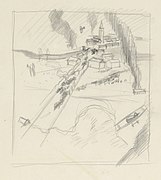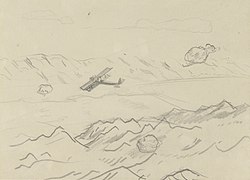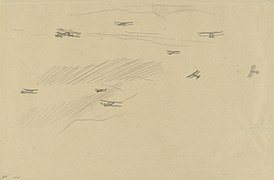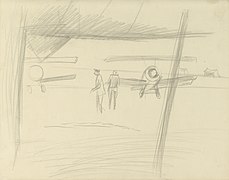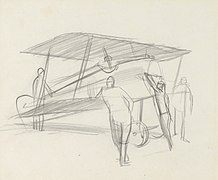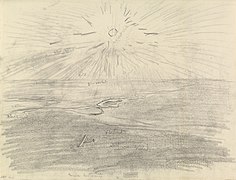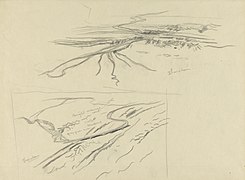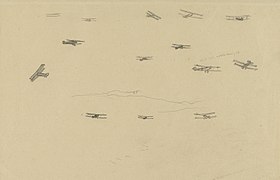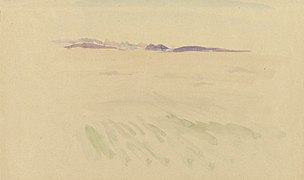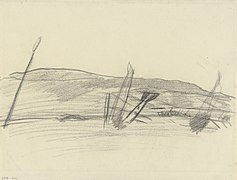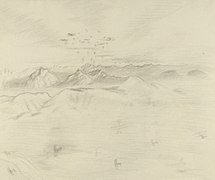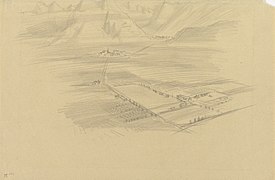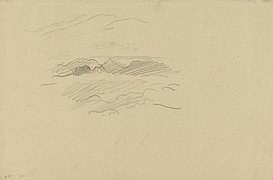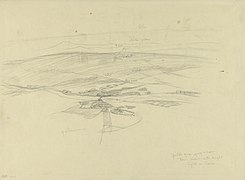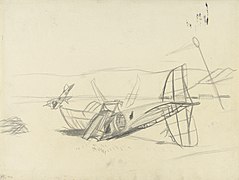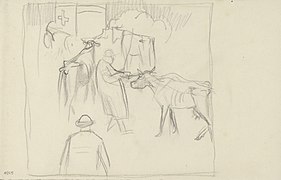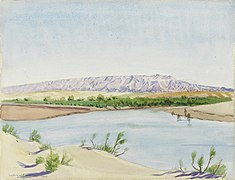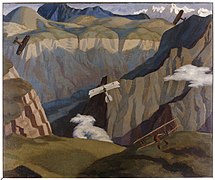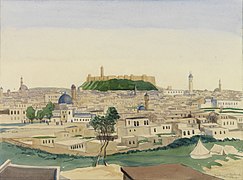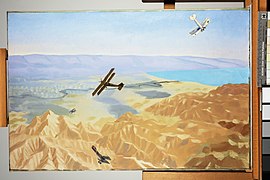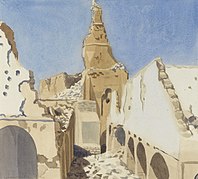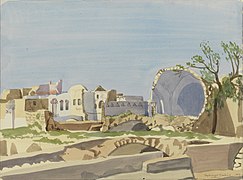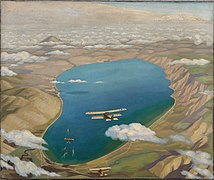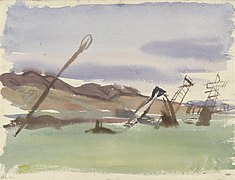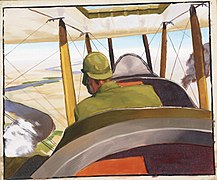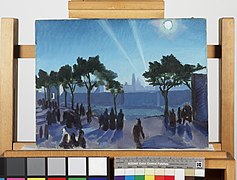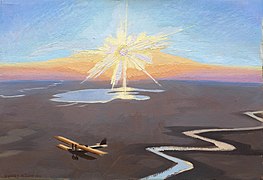Sydney Carline
Sydney William Carline (born August 14, 1888 in London , United Kingdom; † February 14, 1929 there ) was a British painter and teacher. He was known for his aerial combat depictions.
Life
Sydney Carline was the son of the artist George Carline . He was born in London in 1888, his siblings Richard Carline and Hilda Carline were also artists. Sydney Carline was a painter, draftsman, and medalist. He mainly painted landscapes and portraits, he completed his studies at the Slade School of Fine Art from 1907 to 1910 and later in Paris. When the First World War broke out, he joined the Royal Flight Squadron with his brother Richard and served on the Western Front in the Middle East . During his time in Palestine , he made his most famous war painting - The Destruction of the Turkish Transport . Sydney became known as a famous painter around 1918. Richard and Sydney had the task of documenting and depicting the events in theaters of war and thereby recording both victories and painful defeats, such as the siege of Kut al-Amara, for eternity. Most of the paintings depicted dogfights and life as a pilot in the Royal Flying Corps and the Royal Air Force . Sydney Carline was one of the first pilots in the Royal Flying Corps. In some of Carline's oil paintings, the viewer takes the place of the pilot and follows the lines of other aircraft over landscapes and through clouds of smoke. The colors used by Carline make the landscape appear restrictive.
During the First World War
When the First World War broke out, Carline joined the British Army, initially as a courier until he became a pilot in the Royal Air Squadron in 1916. In France he was shot and wounded. He survived and then became a pilot of a single-seat aircraft called Sopwith Camel on the Italian front until the end of 1917. During his time in Italy he set up a studio in a museum in Vicenza. Until February 1918, he sketched battle scenes there without an official commission. His brother Richard helped him to become an official war painter. In this context he sketched, among other things, aerial battles on the Italian front from July to November 1918. In order to be able to document these dogfights as well as possible, he was assigned to the RAF section because of his piloting experience.
In 1919 the Imperial War Museum sent Sydney and Richard to the Middle East. As the official war painter of the Royal Air Force, it was her job to depict aerial combat. They toured the region around Jerusalem. In addition to their military duties, they also visited historical and archaeological sites. In Wadi Fara they made some sketches, which later probably represent the work The Destruction of the Turkish Transport in the Gorge of the Wadi Fara, Palestine . The work depicts an attack on the Turkish troops in a steep gorge. After the brothers spent some time in Beirut, they were sent to Cairo and then to Baghdad . Eventually they were sent to Mosul , where the RAF was planning a bomb attack against the Kurdish insurgents. Before this could be carried out in 1919, however, the two were called back to England .
After the war, Sydney Carline taught at Oxford, and in 1922 he became a member of the London Group. In 1920 the two brothers Richard and Sydney exhibited their paintings at an exhibition. Six years later, Sydney illustrated TE Lawrence's uprising in the desert. In 1920 the two brothers exhibited their works, which were made in Palestine and Mesopotamia , in the Goupil Gallery in London. Although some of the exhibited pictures did not relate to the war, such as the two pictures Mount Hermon and Mount Sannin above the Clouds, Palestine and Jerusalem and the Dead Sea from an Airplane , which were made by Richard Carline. At that time only a very small part of the population was able to fly. The pictures thus mark the permanent sights of the Holy Land and the technical progress. The British military presence is not visible in many of the pictures, instead the landscape of the Holy Land is shown in the pictures.
Death and inheritance
Due to funding constraints, the RAF section of the Imperial War Museum (IWM) did not purchase as many paintings as expected. After Carline's death, Richard offered the museum additional drawings and paintings from the time Carline worked for the museum. Over a hundred works by Carline were handed over to the museum. Carline's works were also loaned for an exhibition at the Usher Art Gallery in Lincoln in 1929.
List of works by galleries
The Ashmolean Museum of Art and Archeology
- Over the Hills of Kurdistan: Flying above Kirkuk (1919)
Usher Gallery
- Village by Lake Orta, Italy
Manchester Art Gallery
- The Walnut Tree (1928)
Ruskin School of Drawing and Fine Art, University of Oxford
- Self portrait
Rozelle House Galleries
- Snow in Hampstead (1926)
IWM (Imperial War Museum) London
- Among the Anti-Aircraft Bursts at 20,000 Feet above the Alps: A British Air Squadron Crossing the Anglo-Austrian Line along the River Piave, Italy (1918)
- A Destroyed Turkish Aerodrome at Rayak, Lebanon, 1919 (1920)
- Aerodrome with Camouflaged Hangars (1918)
- “Sopwith Camel” Patrol Attacking an Austrian Aerodrome near Sacile, Italy (1918)
- A British Pilot in a BE2c Approaching Hit along the Course of the River Euphrates, July (1919)
- “Sopwith Camel” Patrol Attacking Austrian Troops Retreating along the Road to Udine, Italy (1918)
- The Dead Sea: An Enemy Airplane over the Dead Sea, Palestine (1920)
- Study for “The Dead Sea: An Enemy Airplane over the Dead Sea, Palestine” (1920)
- Austrian Dugout beyond Mount Grappa after the Italian Advance of October 1918 (1918)
- British Scouts Leaving Their Aerodrome on Patrol over the Asiago Plateau, Italy (1918)
- Two British Planes Attacking the Turkish Army Corps in the Gorge of the Wadi Baroda, Lebanon, September 30, 1918 (1919)
- Study for “The Dead Sea: An Enemy Airplane over the Dead Sea, Palestine” (1919)
- Flying over the Desert at Sunset, Mesopotamia (1919)
- The Sea of Galilee: Airplanes Attacking Turkish Boats (1919)
- The Destruction of the Turkish Transport in the Gorge of the Wadi Fara, Palestine (1920)
- Study for “The Destruction of the Turkish Transport in the Gorge of the Wadi Fara, Palestine” (1919)
- The Hills of Judea (1919)
- The Destruction of an Austrian Machine in the Gorge of the Brenta Valley, Italy (1918)
- Austrian Prisoners Driven in from the Austrian Lines (1918)
- British “Maurice Farman” Attacked by a German “Fokker” While Dropping Sacks of Corn on Kut-el-Amara during the Siege of 1916 (1919)
- Italians Leaving Padua on Account of the Raids (1918)
Calderdale Metropolitan Borough Council
- Mostar, Herzegovina (1922)
Royal Air Force Museum
- Italian Front (1918)
York Museums Trust
- The Trail of War (1919)
Tate
- Bank Holiday on Hampstead Heath (1915)
- St. John's, Downshire Hill, Hampstead (1927-28)
gallery
- Sketches Sydney Carline
- Sydney Carline painting
literature
- Merion Harries, Susie Harries: The War Artists. British Official War Art of the Twentieth Century. Ed .: Michael Joseph with The Imperial War Museum & the Tate Gallery, London 1983, ISBN 071812314X
Web links
- Art UK, Artworks by Sydney William Carline , accessed April 1, 2018
Individual evidence
- ^ Sydney Carline. In: Tate. Retrieved February 15, 2018 .
- ↑ a b Benezit Dictionary of British Graphic Artists and Illustrators . tape 1 . Oxford University Press, Oxford, New York 2012, ISBN 978-0-19-992305-2 , pp. 215 .
- ^ A b John Simkin: Sydney Carline. In: Spartacus Educational. August 2014, accessed February 5, 2018 .
- ↑ Michael JK Walsh, Andrekos Varnava: The Great War and the British Empire: Culture and Society . Routledge, Taylor & Francis Group, London / New York 2017, ISBN 978-1-4724-6227-5 , pp. 18 .
- ↑ John Fairley: Horses of the Great War: The Story in Art . Pen and Sword Military, South Yorkshire 2015, ISBN 978-1-4738-4826-9 , pp. 160 .
- ^ Clare Saxby: War in the sunshine. In: The times Literary supplement. February 1, 2017, accessed February 16, 2018 .
- ^ A b Merion Harries & Susie Harries: The War Artists. British Official War Art of the Twentieth Century. Ed .: Michael Joseph with The Imperial War Museum & the Tate Gallery. 1st ed. London 1983, ISBN 0-7181-2314-X , pp. 310 .
- ↑ Laura Cumming: War in the Sunshine. In: The Observer. January 15, 2017, accessed February 15, 2018 .
- ^ War in the Sunshine: The British in Italy 1917–1918. In: Art Fund. 2017, accessed February 16, 2018 .
- ^ Rory Miller: Britain, Palestine and Empire: The Mandate Years . Routledge, Taylor & Francis Group, London, New York 2016, ISBN 978-0-7546-6808-4 , pp. 89.90 .
- ^ IWM: Carline, Sydney. 2018, accessed February 15, 2018 .
- ↑ Discover artworks, Sdney William Carline. In: ART UK. Retrieved February 15, 2018 .
| personal data | |
|---|---|
| SURNAME | Carline, Sydney |
| ALTERNATIVE NAMES | Carline, Sydney William (full name) |
| BRIEF DESCRIPTION | British painter and teacher |
| DATE OF BIRTH | August 14, 1888 |
| PLACE OF BIRTH | London |
| DATE OF DEATH | February 14, 1929 |
| Place of death | London |



